Environment Management in Organizations: A Comprehensive Analysis
VerifiedAdded on 2022/10/19
|9
|2424
|414
Essay
AI Summary
This essay delves into the crucial role of environmental management within organizations, addressing the detrimental effects of pollution and the increasing need for sustainable practices. It highlights the significance of Environmental Management Systems (EMS) in mitigating environmental impact and promoting corporate responsibility. The essay discusses various factors leading to industrial pollution, including unethical practices, outdated technologies, ineffective policy implementation, and improper waste management. It also examines the positive aspects of implementing EMS, such as improved brand value, cost-effectiveness, risk management, and the ability to align with green business models. Furthermore, the essay acknowledges the limitations of EMS implementation, such as financial costs and the need for workforce awareness, while also outlining the key steps involved in establishing and maintaining an effective EMS. The essay concludes by emphasizing the growing importance of environmental management in organizations and its potential to strengthen their functions and improve their overall performance, particularly in the context of rising consumer and stakeholder interest in sustainable and eco-friendly practices. The essay references various research papers and publications to support its arguments, providing a comprehensive analysis of the subject.
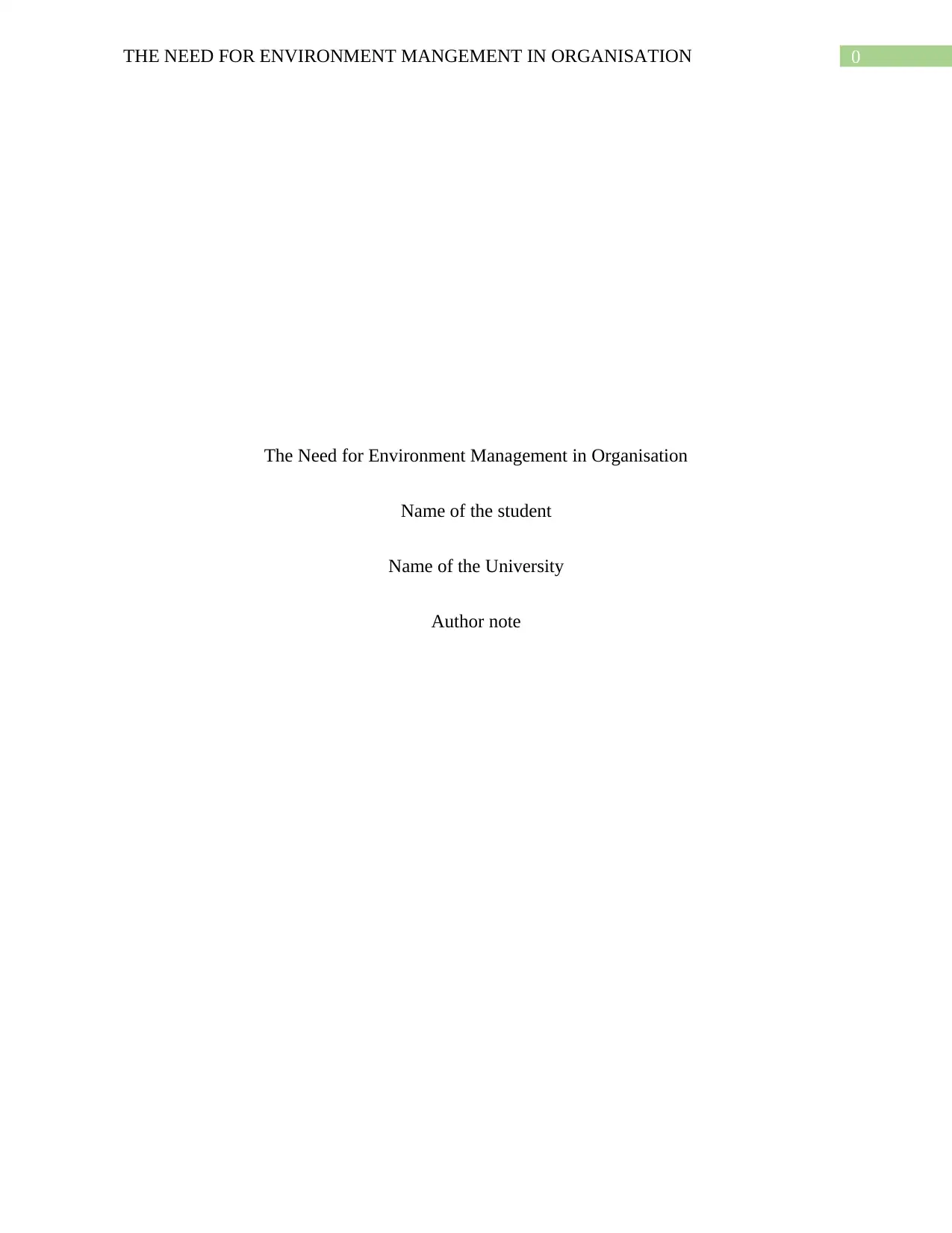
0THE NEED FOR ENVIRONMENT MANGEMENT IN ORGANISATION
The Need for Environment Management in Organisation
Name of the student
Name of the University
Author note
The Need for Environment Management in Organisation
Name of the student
Name of the University
Author note
Paraphrase This Document
Need a fresh take? Get an instant paraphrase of this document with our AI Paraphraser
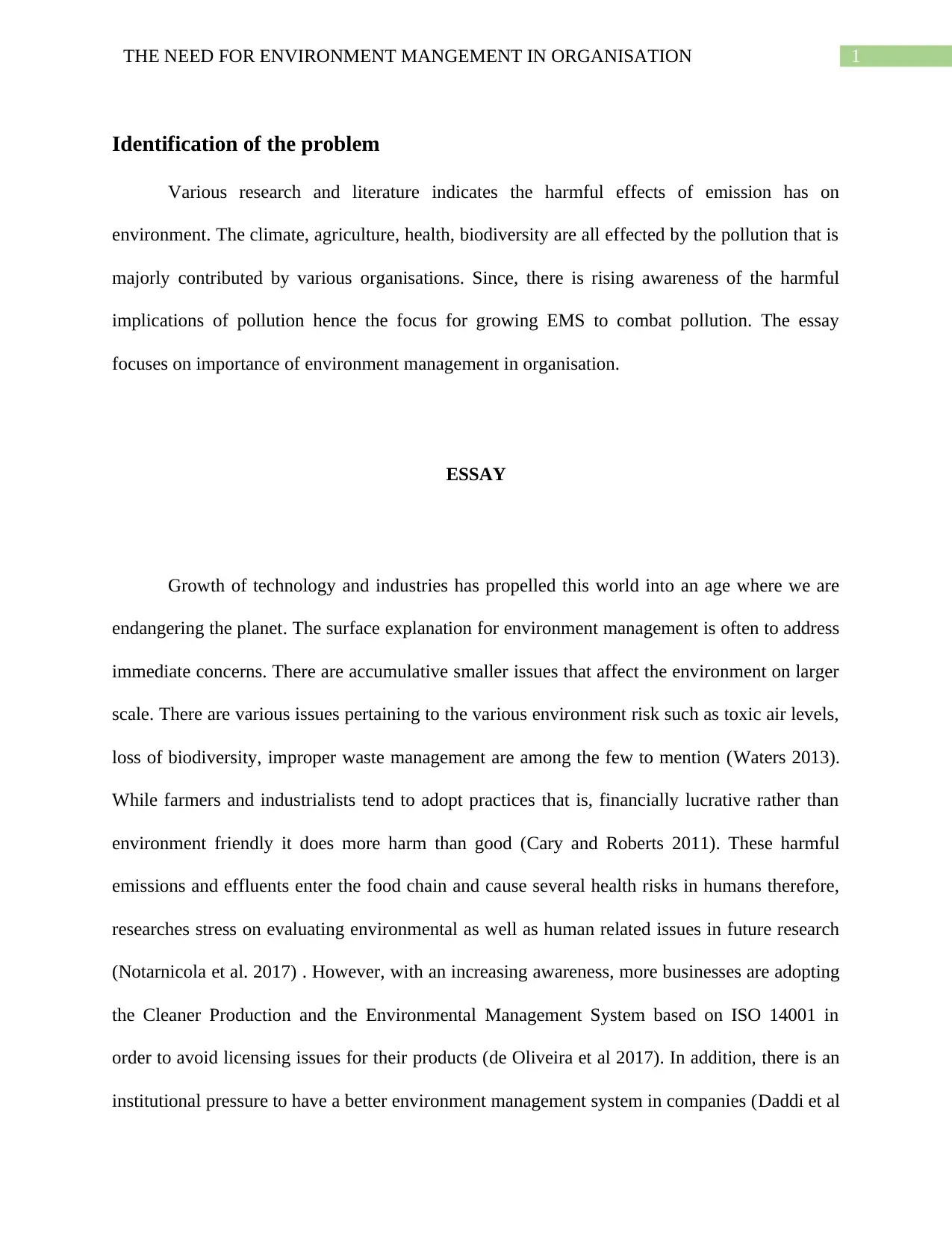
1THE NEED FOR ENVIRONMENT MANGEMENT IN ORGANISATION
Identification of the problem
Various research and literature indicates the harmful effects of emission has on
environment. The climate, agriculture, health, biodiversity are all effected by the pollution that is
majorly contributed by various organisations. Since, there is rising awareness of the harmful
implications of pollution hence the focus for growing EMS to combat pollution. The essay
focuses on importance of environment management in organisation.
ESSAY
Growth of technology and industries has propelled this world into an age where we are
endangering the planet. The surface explanation for environment management is often to address
immediate concerns. There are accumulative smaller issues that affect the environment on larger
scale. There are various issues pertaining to the various environment risk such as toxic air levels,
loss of biodiversity, improper waste management are among the few to mention (Waters 2013).
While farmers and industrialists tend to adopt practices that is, financially lucrative rather than
environment friendly it does more harm than good (Cary and Roberts 2011). These harmful
emissions and effluents enter the food chain and cause several health risks in humans therefore,
researches stress on evaluating environmental as well as human related issues in future research
(Notarnicola et al. 2017) . However, with an increasing awareness, more businesses are adopting
the Cleaner Production and the Environmental Management System based on ISO 14001 in
order to avoid licensing issues for their products (de Oliveira et al 2017). In addition, there is an
institutional pressure to have a better environment management system in companies (Daddi et al
Identification of the problem
Various research and literature indicates the harmful effects of emission has on
environment. The climate, agriculture, health, biodiversity are all effected by the pollution that is
majorly contributed by various organisations. Since, there is rising awareness of the harmful
implications of pollution hence the focus for growing EMS to combat pollution. The essay
focuses on importance of environment management in organisation.
ESSAY
Growth of technology and industries has propelled this world into an age where we are
endangering the planet. The surface explanation for environment management is often to address
immediate concerns. There are accumulative smaller issues that affect the environment on larger
scale. There are various issues pertaining to the various environment risk such as toxic air levels,
loss of biodiversity, improper waste management are among the few to mention (Waters 2013).
While farmers and industrialists tend to adopt practices that is, financially lucrative rather than
environment friendly it does more harm than good (Cary and Roberts 2011). These harmful
emissions and effluents enter the food chain and cause several health risks in humans therefore,
researches stress on evaluating environmental as well as human related issues in future research
(Notarnicola et al. 2017) . However, with an increasing awareness, more businesses are adopting
the Cleaner Production and the Environmental Management System based on ISO 14001 in
order to avoid licensing issues for their products (de Oliveira et al 2017). In addition, there is an
institutional pressure to have a better environment management system in companies (Daddi et al
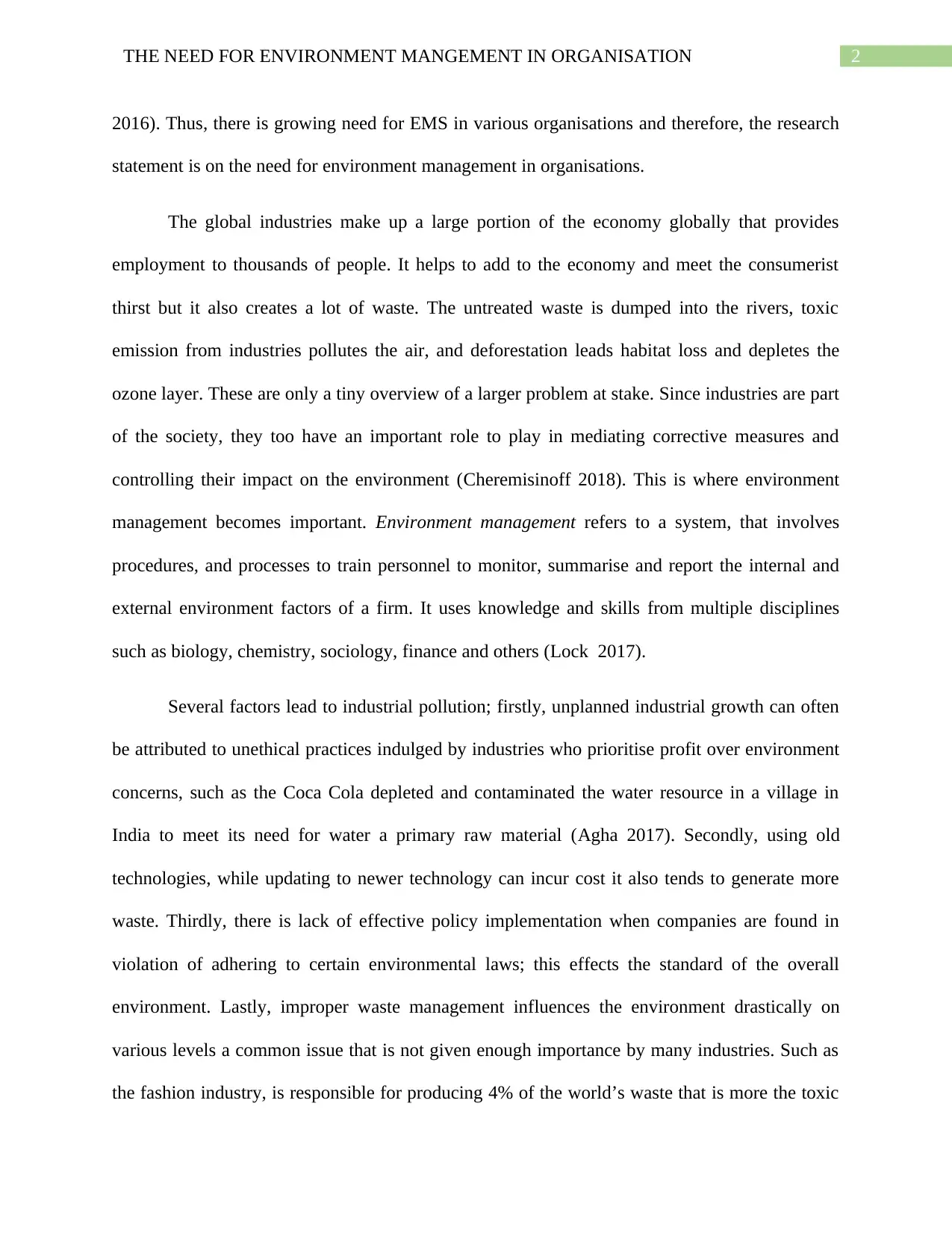
2THE NEED FOR ENVIRONMENT MANGEMENT IN ORGANISATION
2016). Thus, there is growing need for EMS in various organisations and therefore, the research
statement is on the need for environment management in organisations.
The global industries make up a large portion of the economy globally that provides
employment to thousands of people. It helps to add to the economy and meet the consumerist
thirst but it also creates a lot of waste. The untreated waste is dumped into the rivers, toxic
emission from industries pollutes the air, and deforestation leads habitat loss and depletes the
ozone layer. These are only a tiny overview of a larger problem at stake. Since industries are part
of the society, they too have an important role to play in mediating corrective measures and
controlling their impact on the environment (Cheremisinoff 2018). This is where environment
management becomes important. Environment management refers to a system, that involves
procedures, and processes to train personnel to monitor, summarise and report the internal and
external environment factors of a firm. It uses knowledge and skills from multiple disciplines
such as biology, chemistry, sociology, finance and others (Lock 2017).
Several factors lead to industrial pollution; firstly, unplanned industrial growth can often
be attributed to unethical practices indulged by industries who prioritise profit over environment
concerns, such as the Coca Cola depleted and contaminated the water resource in a village in
India to meet its need for water a primary raw material (Agha 2017). Secondly, using old
technologies, while updating to newer technology can incur cost it also tends to generate more
waste. Thirdly, there is lack of effective policy implementation when companies are found in
violation of adhering to certain environmental laws; this effects the standard of the overall
environment. Lastly, improper waste management influences the environment drastically on
various levels a common issue that is not given enough importance by many industries. Such as
the fashion industry, is responsible for producing 4% of the world’s waste that is more the toxic
2016). Thus, there is growing need for EMS in various organisations and therefore, the research
statement is on the need for environment management in organisations.
The global industries make up a large portion of the economy globally that provides
employment to thousands of people. It helps to add to the economy and meet the consumerist
thirst but it also creates a lot of waste. The untreated waste is dumped into the rivers, toxic
emission from industries pollutes the air, and deforestation leads habitat loss and depletes the
ozone layer. These are only a tiny overview of a larger problem at stake. Since industries are part
of the society, they too have an important role to play in mediating corrective measures and
controlling their impact on the environment (Cheremisinoff 2018). This is where environment
management becomes important. Environment management refers to a system, that involves
procedures, and processes to train personnel to monitor, summarise and report the internal and
external environment factors of a firm. It uses knowledge and skills from multiple disciplines
such as biology, chemistry, sociology, finance and others (Lock 2017).
Several factors lead to industrial pollution; firstly, unplanned industrial growth can often
be attributed to unethical practices indulged by industries who prioritise profit over environment
concerns, such as the Coca Cola depleted and contaminated the water resource in a village in
India to meet its need for water a primary raw material (Agha 2017). Secondly, using old
technologies, while updating to newer technology can incur cost it also tends to generate more
waste. Thirdly, there is lack of effective policy implementation when companies are found in
violation of adhering to certain environmental laws; this effects the standard of the overall
environment. Lastly, improper waste management influences the environment drastically on
various levels a common issue that is not given enough importance by many industries. Such as
the fashion industry, is responsible for producing 4% of the world’s waste that is more the toxic
⊘ This is a preview!⊘
Do you want full access?
Subscribe today to unlock all pages.

Trusted by 1+ million students worldwide
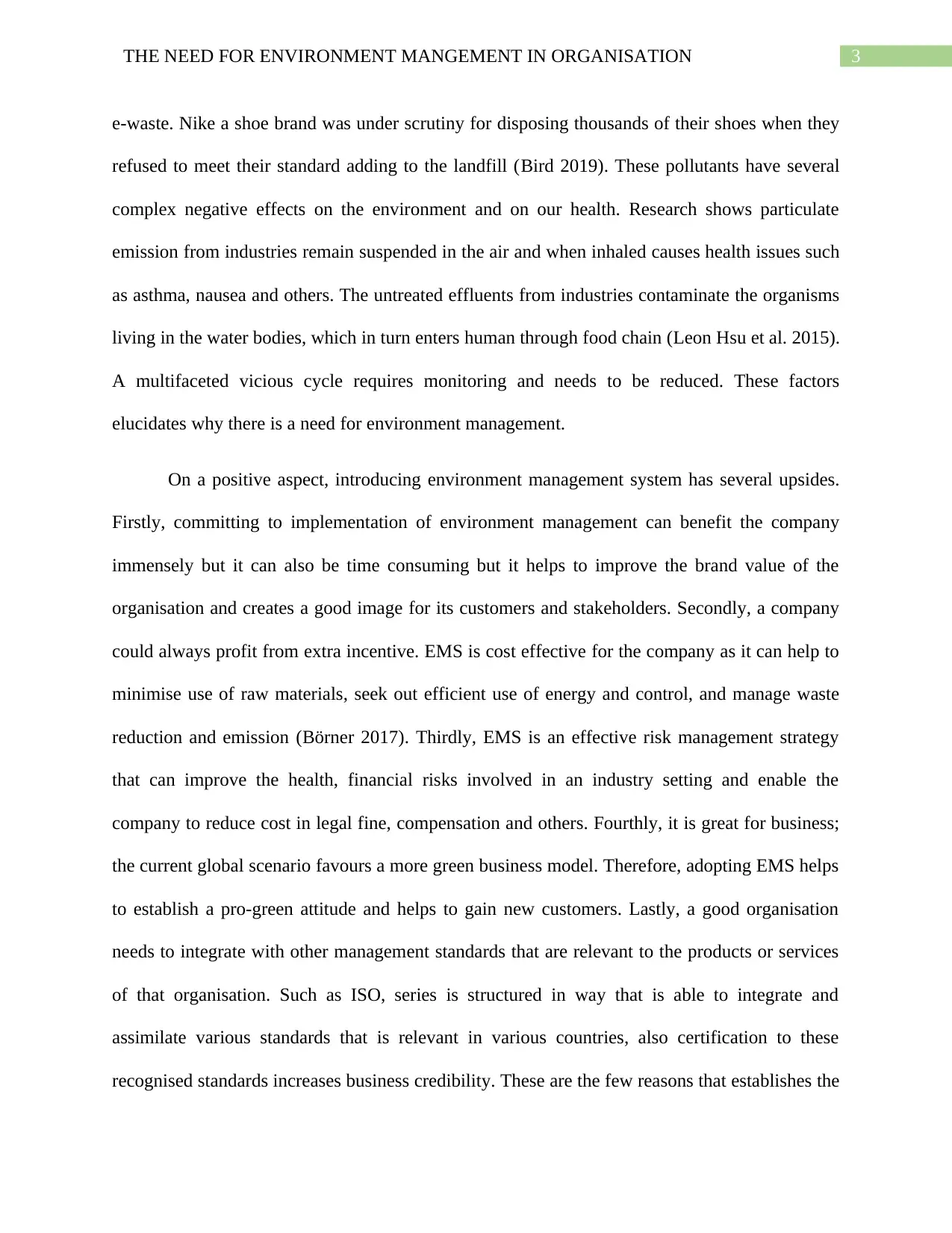
3THE NEED FOR ENVIRONMENT MANGEMENT IN ORGANISATION
e-waste. Nike a shoe brand was under scrutiny for disposing thousands of their shoes when they
refused to meet their standard adding to the landfill (Bird 2019). These pollutants have several
complex negative effects on the environment and on our health. Research shows particulate
emission from industries remain suspended in the air and when inhaled causes health issues such
as asthma, nausea and others. The untreated effluents from industries contaminate the organisms
living in the water bodies, which in turn enters human through food chain (Leon Hsu et al. 2015).
A multifaceted vicious cycle requires monitoring and needs to be reduced. These factors
elucidates why there is a need for environment management.
On a positive aspect, introducing environment management system has several upsides.
Firstly, committing to implementation of environment management can benefit the company
immensely but it can also be time consuming but it helps to improve the brand value of the
organisation and creates a good image for its customers and stakeholders. Secondly, a company
could always profit from extra incentive. EMS is cost effective for the company as it can help to
minimise use of raw materials, seek out efficient use of energy and control, and manage waste
reduction and emission (Börner 2017). Thirdly, EMS is an effective risk management strategy
that can improve the health, financial risks involved in an industry setting and enable the
company to reduce cost in legal fine, compensation and others. Fourthly, it is great for business;
the current global scenario favours a more green business model. Therefore, adopting EMS helps
to establish a pro-green attitude and helps to gain new customers. Lastly, a good organisation
needs to integrate with other management standards that are relevant to the products or services
of that organisation. Such as ISO, series is structured in way that is able to integrate and
assimilate various standards that is relevant in various countries, also certification to these
recognised standards increases business credibility. These are the few reasons that establishes the
e-waste. Nike a shoe brand was under scrutiny for disposing thousands of their shoes when they
refused to meet their standard adding to the landfill (Bird 2019). These pollutants have several
complex negative effects on the environment and on our health. Research shows particulate
emission from industries remain suspended in the air and when inhaled causes health issues such
as asthma, nausea and others. The untreated effluents from industries contaminate the organisms
living in the water bodies, which in turn enters human through food chain (Leon Hsu et al. 2015).
A multifaceted vicious cycle requires monitoring and needs to be reduced. These factors
elucidates why there is a need for environment management.
On a positive aspect, introducing environment management system has several upsides.
Firstly, committing to implementation of environment management can benefit the company
immensely but it can also be time consuming but it helps to improve the brand value of the
organisation and creates a good image for its customers and stakeholders. Secondly, a company
could always profit from extra incentive. EMS is cost effective for the company as it can help to
minimise use of raw materials, seek out efficient use of energy and control, and manage waste
reduction and emission (Börner 2017). Thirdly, EMS is an effective risk management strategy
that can improve the health, financial risks involved in an industry setting and enable the
company to reduce cost in legal fine, compensation and others. Fourthly, it is great for business;
the current global scenario favours a more green business model. Therefore, adopting EMS helps
to establish a pro-green attitude and helps to gain new customers. Lastly, a good organisation
needs to integrate with other management standards that are relevant to the products or services
of that organisation. Such as ISO, series is structured in way that is able to integrate and
assimilate various standards that is relevant in various countries, also certification to these
recognised standards increases business credibility. These are the few reasons that establishes the
Paraphrase This Document
Need a fresh take? Get an instant paraphrase of this document with our AI Paraphraser
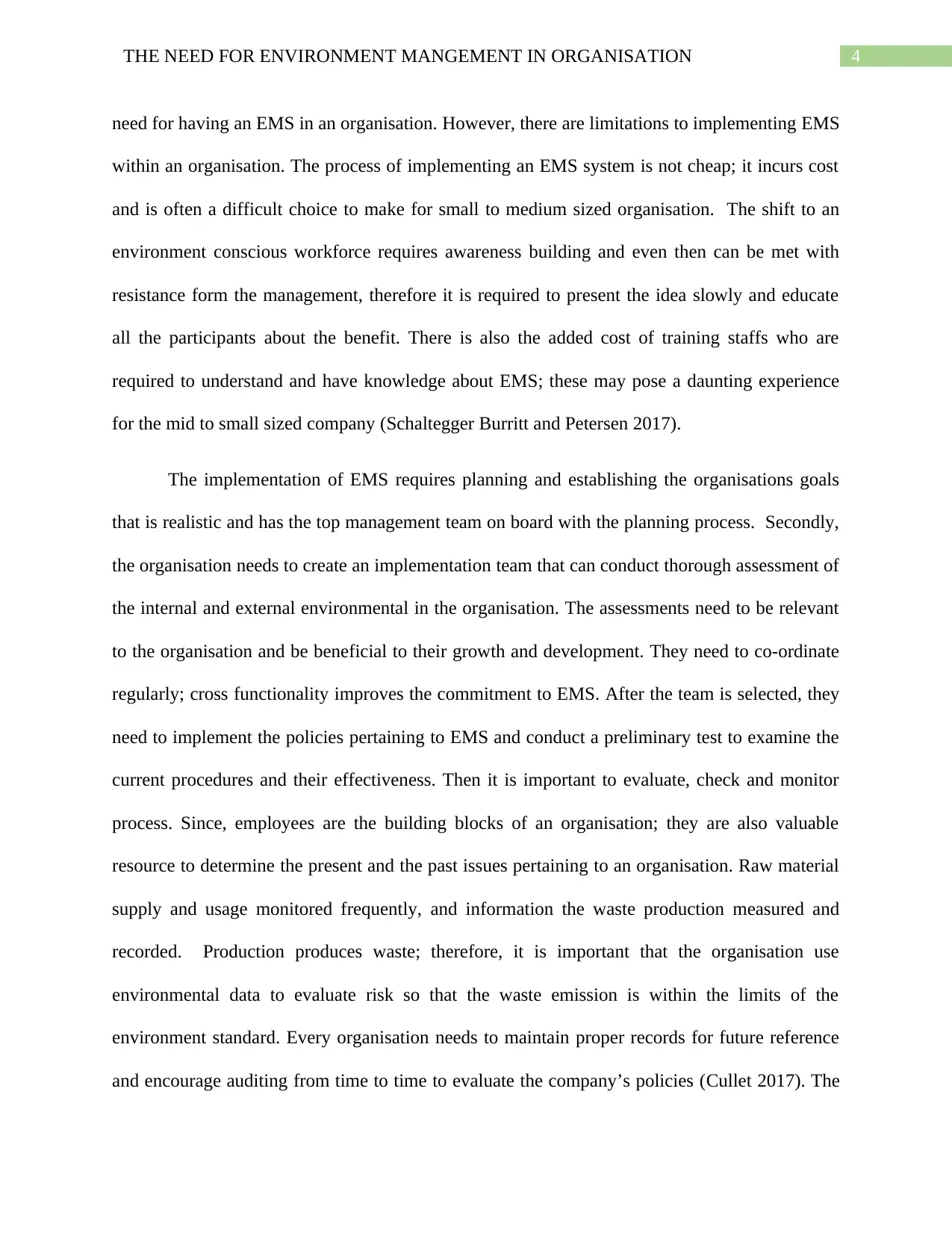
4THE NEED FOR ENVIRONMENT MANGEMENT IN ORGANISATION
need for having an EMS in an organisation. However, there are limitations to implementing EMS
within an organisation. The process of implementing an EMS system is not cheap; it incurs cost
and is often a difficult choice to make for small to medium sized organisation. The shift to an
environment conscious workforce requires awareness building and even then can be met with
resistance form the management, therefore it is required to present the idea slowly and educate
all the participants about the benefit. There is also the added cost of training staffs who are
required to understand and have knowledge about EMS; these may pose a daunting experience
for the mid to small sized company (Schaltegger Burritt and Petersen 2017).
The implementation of EMS requires planning and establishing the organisations goals
that is realistic and has the top management team on board with the planning process. Secondly,
the organisation needs to create an implementation team that can conduct thorough assessment of
the internal and external environmental in the organisation. The assessments need to be relevant
to the organisation and be beneficial to their growth and development. They need to co-ordinate
regularly; cross functionality improves the commitment to EMS. After the team is selected, they
need to implement the policies pertaining to EMS and conduct a preliminary test to examine the
current procedures and their effectiveness. Then it is important to evaluate, check and monitor
process. Since, employees are the building blocks of an organisation; they are also valuable
resource to determine the present and the past issues pertaining to an organisation. Raw material
supply and usage monitored frequently, and information the waste production measured and
recorded. Production produces waste; therefore, it is important that the organisation use
environmental data to evaluate risk so that the waste emission is within the limits of the
environment standard. Every organisation needs to maintain proper records for future reference
and encourage auditing from time to time to evaluate the company’s policies (Cullet 2017). The
need for having an EMS in an organisation. However, there are limitations to implementing EMS
within an organisation. The process of implementing an EMS system is not cheap; it incurs cost
and is often a difficult choice to make for small to medium sized organisation. The shift to an
environment conscious workforce requires awareness building and even then can be met with
resistance form the management, therefore it is required to present the idea slowly and educate
all the participants about the benefit. There is also the added cost of training staffs who are
required to understand and have knowledge about EMS; these may pose a daunting experience
for the mid to small sized company (Schaltegger Burritt and Petersen 2017).
The implementation of EMS requires planning and establishing the organisations goals
that is realistic and has the top management team on board with the planning process. Secondly,
the organisation needs to create an implementation team that can conduct thorough assessment of
the internal and external environmental in the organisation. The assessments need to be relevant
to the organisation and be beneficial to their growth and development. They need to co-ordinate
regularly; cross functionality improves the commitment to EMS. After the team is selected, they
need to implement the policies pertaining to EMS and conduct a preliminary test to examine the
current procedures and their effectiveness. Then it is important to evaluate, check and monitor
process. Since, employees are the building blocks of an organisation; they are also valuable
resource to determine the present and the past issues pertaining to an organisation. Raw material
supply and usage monitored frequently, and information the waste production measured and
recorded. Production produces waste; therefore, it is important that the organisation use
environmental data to evaluate risk so that the waste emission is within the limits of the
environment standard. Every organisation needs to maintain proper records for future reference
and encourage auditing from time to time to evaluate the company’s policies (Cullet 2017). The
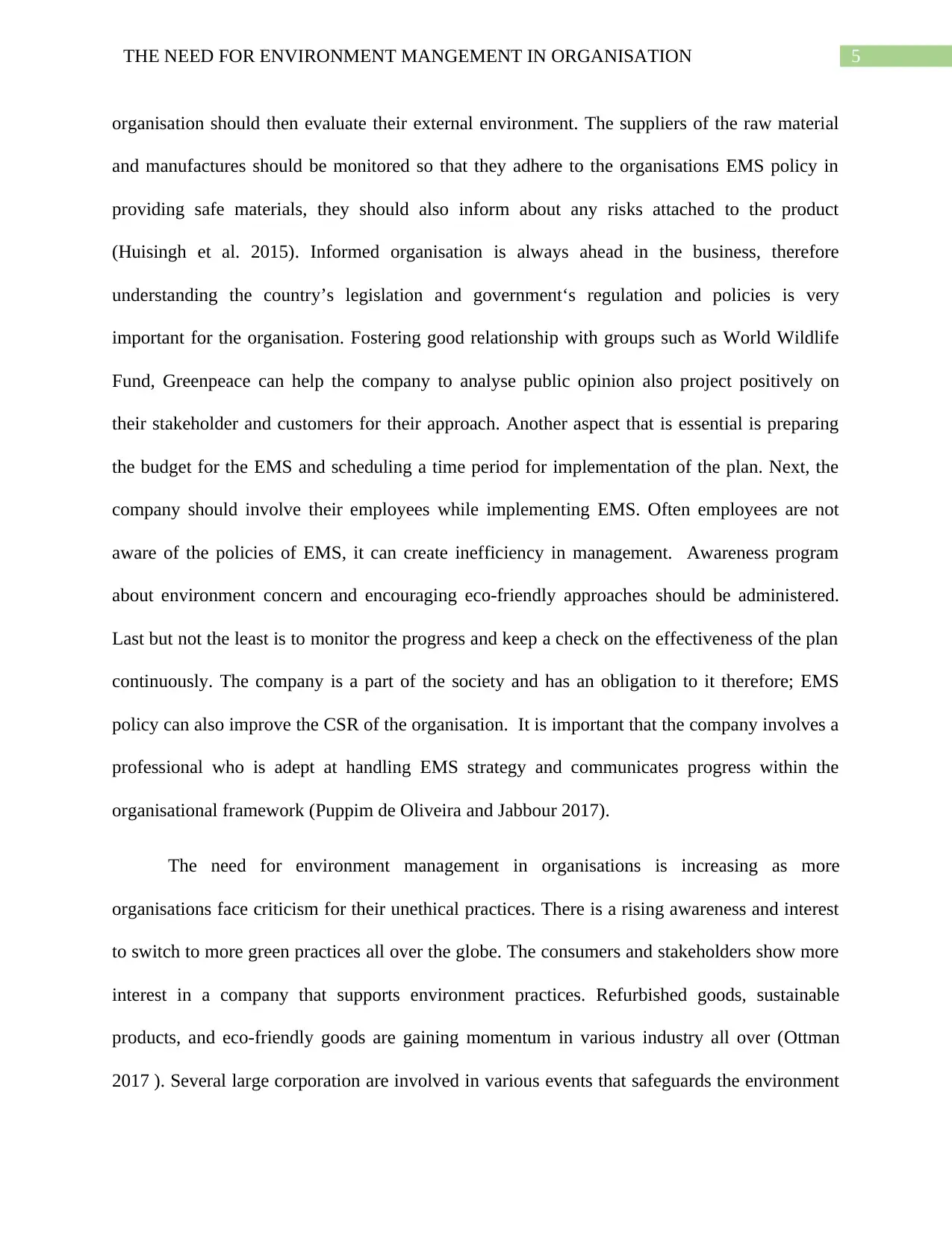
5THE NEED FOR ENVIRONMENT MANGEMENT IN ORGANISATION
organisation should then evaluate their external environment. The suppliers of the raw material
and manufactures should be monitored so that they adhere to the organisations EMS policy in
providing safe materials, they should also inform about any risks attached to the product
(Huisingh et al. 2015). Informed organisation is always ahead in the business, therefore
understanding the country’s legislation and government‘s regulation and policies is very
important for the organisation. Fostering good relationship with groups such as World Wildlife
Fund, Greenpeace can help the company to analyse public opinion also project positively on
their stakeholder and customers for their approach. Another aspect that is essential is preparing
the budget for the EMS and scheduling a time period for implementation of the plan. Next, the
company should involve their employees while implementing EMS. Often employees are not
aware of the policies of EMS, it can create inefficiency in management. Awareness program
about environment concern and encouraging eco-friendly approaches should be administered.
Last but not the least is to monitor the progress and keep a check on the effectiveness of the plan
continuously. The company is a part of the society and has an obligation to it therefore; EMS
policy can also improve the CSR of the organisation. It is important that the company involves a
professional who is adept at handling EMS strategy and communicates progress within the
organisational framework (Puppim de Oliveira and Jabbour 2017).
The need for environment management in organisations is increasing as more
organisations face criticism for their unethical practices. There is a rising awareness and interest
to switch to more green practices all over the globe. The consumers and stakeholders show more
interest in a company that supports environment practices. Refurbished goods, sustainable
products, and eco-friendly goods are gaining momentum in various industry all over (Ottman
2017 ). Several large corporation are involved in various events that safeguards the environment
organisation should then evaluate their external environment. The suppliers of the raw material
and manufactures should be monitored so that they adhere to the organisations EMS policy in
providing safe materials, they should also inform about any risks attached to the product
(Huisingh et al. 2015). Informed organisation is always ahead in the business, therefore
understanding the country’s legislation and government‘s regulation and policies is very
important for the organisation. Fostering good relationship with groups such as World Wildlife
Fund, Greenpeace can help the company to analyse public opinion also project positively on
their stakeholder and customers for their approach. Another aspect that is essential is preparing
the budget for the EMS and scheduling a time period for implementation of the plan. Next, the
company should involve their employees while implementing EMS. Often employees are not
aware of the policies of EMS, it can create inefficiency in management. Awareness program
about environment concern and encouraging eco-friendly approaches should be administered.
Last but not the least is to monitor the progress and keep a check on the effectiveness of the plan
continuously. The company is a part of the society and has an obligation to it therefore; EMS
policy can also improve the CSR of the organisation. It is important that the company involves a
professional who is adept at handling EMS strategy and communicates progress within the
organisational framework (Puppim de Oliveira and Jabbour 2017).
The need for environment management in organisations is increasing as more
organisations face criticism for their unethical practices. There is a rising awareness and interest
to switch to more green practices all over the globe. The consumers and stakeholders show more
interest in a company that supports environment practices. Refurbished goods, sustainable
products, and eco-friendly goods are gaining momentum in various industry all over (Ottman
2017 ). Several large corporation are involved in various events that safeguards the environment
⊘ This is a preview!⊘
Do you want full access?
Subscribe today to unlock all pages.

Trusted by 1+ million students worldwide
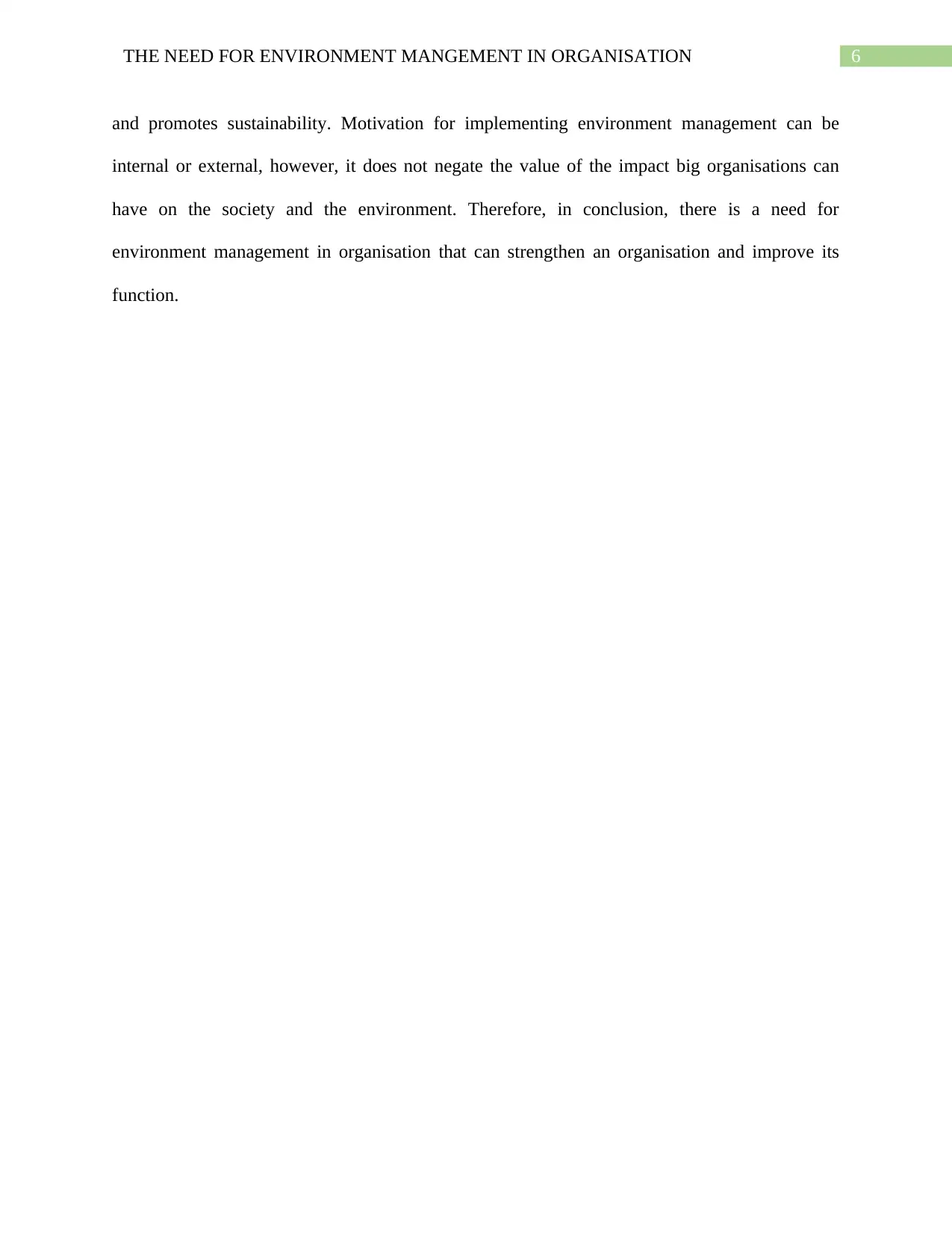
6THE NEED FOR ENVIRONMENT MANGEMENT IN ORGANISATION
and promotes sustainability. Motivation for implementing environment management can be
internal or external, however, it does not negate the value of the impact big organisations can
have on the society and the environment. Therefore, in conclusion, there is a need for
environment management in organisation that can strengthen an organisation and improve its
function.
and promotes sustainability. Motivation for implementing environment management can be
internal or external, however, it does not negate the value of the impact big organisations can
have on the society and the environment. Therefore, in conclusion, there is a need for
environment management in organisation that can strengthen an organisation and improve its
function.
Paraphrase This Document
Need a fresh take? Get an instant paraphrase of this document with our AI Paraphraser
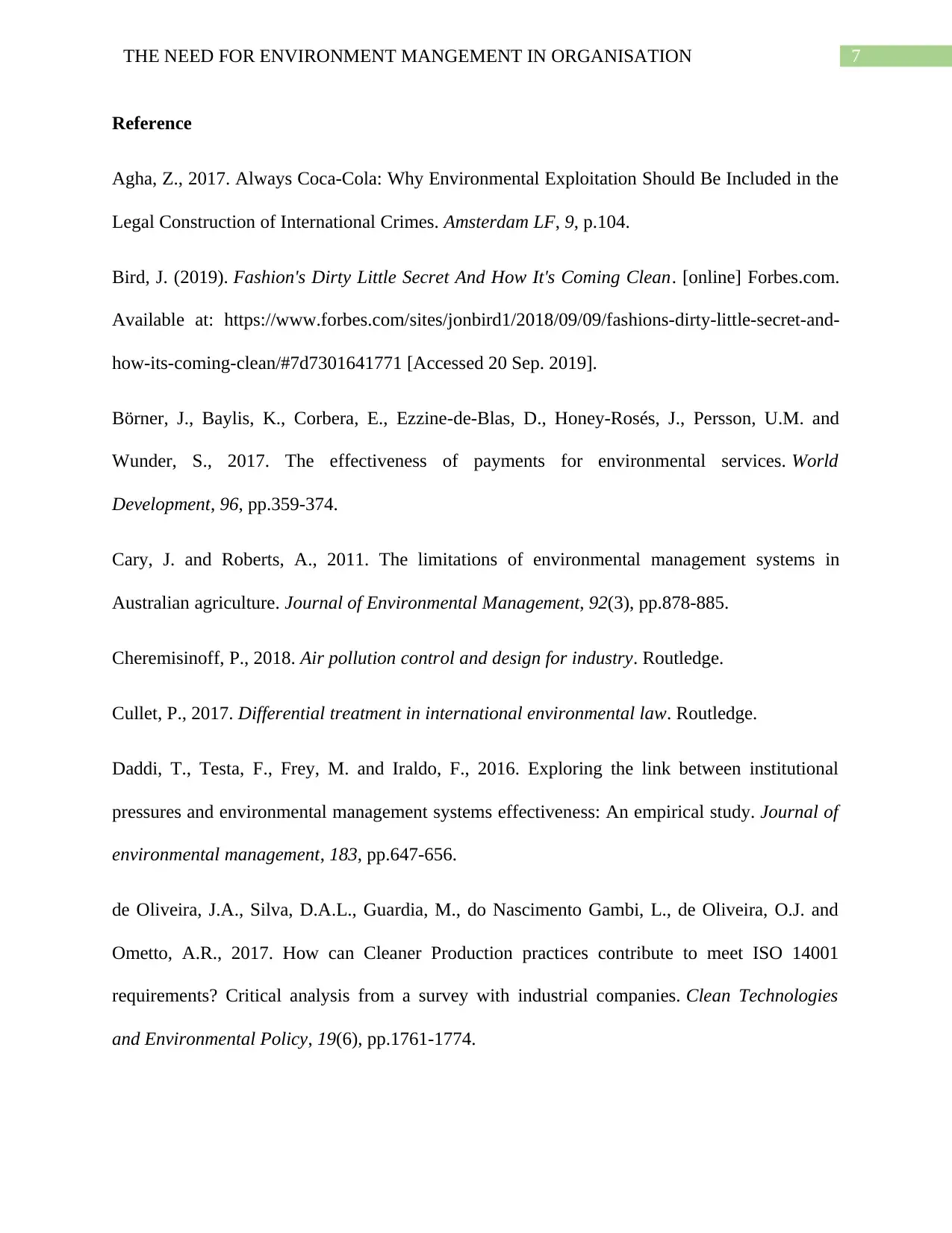
7THE NEED FOR ENVIRONMENT MANGEMENT IN ORGANISATION
Reference
Agha, Z., 2017. Always Coca-Cola: Why Environmental Exploitation Should Be Included in the
Legal Construction of International Crimes. Amsterdam LF, 9, p.104.
Bird, J. (2019). Fashion's Dirty Little Secret And How It's Coming Clean. [online] Forbes.com.
Available at: https://www.forbes.com/sites/jonbird1/2018/09/09/fashions-dirty-little-secret-and-
how-its-coming-clean/#7d7301641771 [Accessed 20 Sep. 2019].
Börner, J., Baylis, K., Corbera, E., Ezzine-de-Blas, D., Honey-Rosés, J., Persson, U.M. and
Wunder, S., 2017. The effectiveness of payments for environmental services. World
Development, 96, pp.359-374.
Cary, J. and Roberts, A., 2011. The limitations of environmental management systems in
Australian agriculture. Journal of Environmental Management, 92(3), pp.878-885.
Cheremisinoff, P., 2018. Air pollution control and design for industry. Routledge.
Cullet, P., 2017. Differential treatment in international environmental law. Routledge.
Daddi, T., Testa, F., Frey, M. and Iraldo, F., 2016. Exploring the link between institutional
pressures and environmental management systems effectiveness: An empirical study. Journal of
environmental management, 183, pp.647-656.
de Oliveira, J.A., Silva, D.A.L., Guardia, M., do Nascimento Gambi, L., de Oliveira, O.J. and
Ometto, A.R., 2017. How can Cleaner Production practices contribute to meet ISO 14001
requirements? Critical analysis from a survey with industrial companies. Clean Technologies
and Environmental Policy, 19(6), pp.1761-1774.
Reference
Agha, Z., 2017. Always Coca-Cola: Why Environmental Exploitation Should Be Included in the
Legal Construction of International Crimes. Amsterdam LF, 9, p.104.
Bird, J. (2019). Fashion's Dirty Little Secret And How It's Coming Clean. [online] Forbes.com.
Available at: https://www.forbes.com/sites/jonbird1/2018/09/09/fashions-dirty-little-secret-and-
how-its-coming-clean/#7d7301641771 [Accessed 20 Sep. 2019].
Börner, J., Baylis, K., Corbera, E., Ezzine-de-Blas, D., Honey-Rosés, J., Persson, U.M. and
Wunder, S., 2017. The effectiveness of payments for environmental services. World
Development, 96, pp.359-374.
Cary, J. and Roberts, A., 2011. The limitations of environmental management systems in
Australian agriculture. Journal of Environmental Management, 92(3), pp.878-885.
Cheremisinoff, P., 2018. Air pollution control and design for industry. Routledge.
Cullet, P., 2017. Differential treatment in international environmental law. Routledge.
Daddi, T., Testa, F., Frey, M. and Iraldo, F., 2016. Exploring the link between institutional
pressures and environmental management systems effectiveness: An empirical study. Journal of
environmental management, 183, pp.647-656.
de Oliveira, J.A., Silva, D.A.L., Guardia, M., do Nascimento Gambi, L., de Oliveira, O.J. and
Ometto, A.R., 2017. How can Cleaner Production practices contribute to meet ISO 14001
requirements? Critical analysis from a survey with industrial companies. Clean Technologies
and Environmental Policy, 19(6), pp.1761-1774.
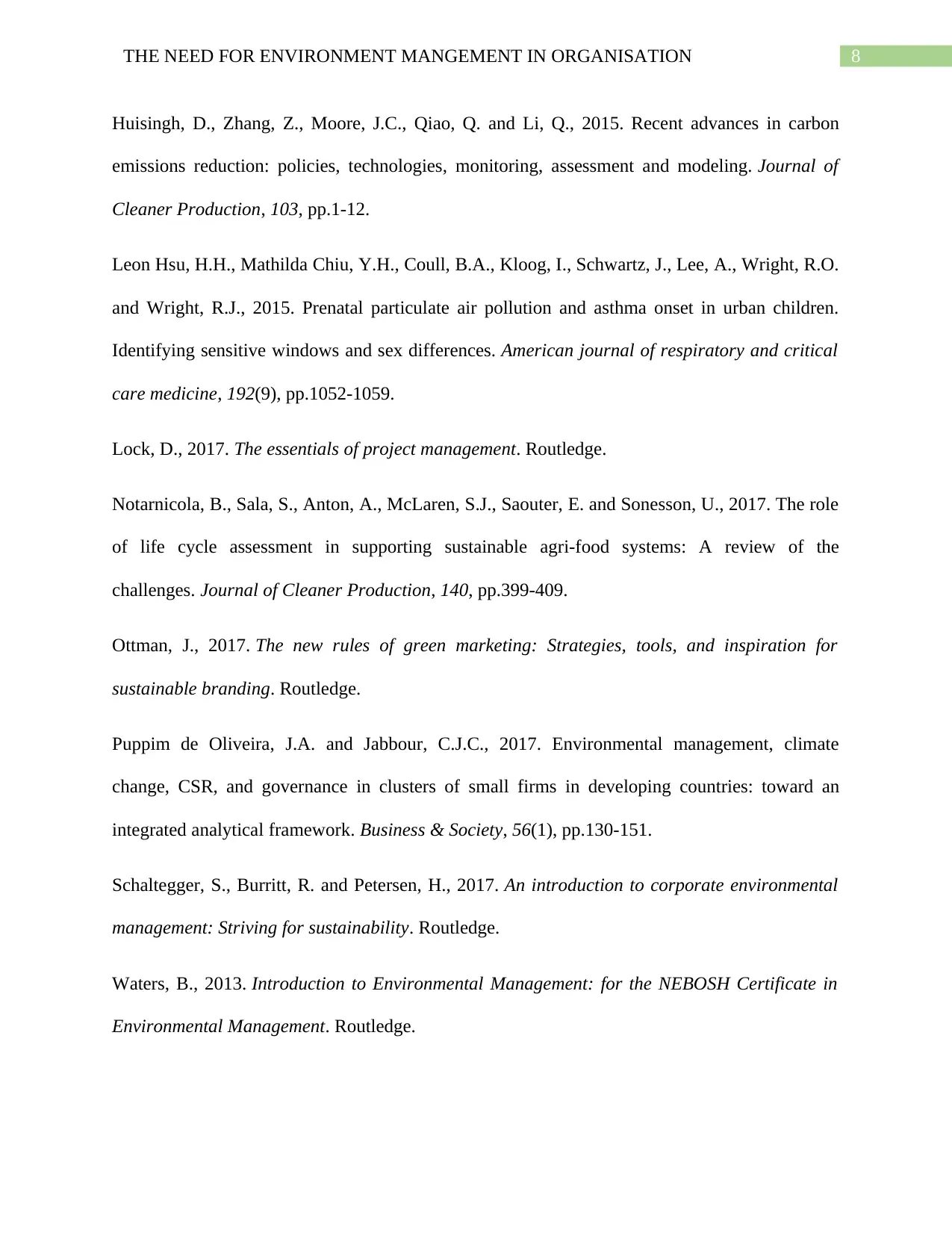
8THE NEED FOR ENVIRONMENT MANGEMENT IN ORGANISATION
Huisingh, D., Zhang, Z., Moore, J.C., Qiao, Q. and Li, Q., 2015. Recent advances in carbon
emissions reduction: policies, technologies, monitoring, assessment and modeling. Journal of
Cleaner Production, 103, pp.1-12.
Leon Hsu, H.H., Mathilda Chiu, Y.H., Coull, B.A., Kloog, I., Schwartz, J., Lee, A., Wright, R.O.
and Wright, R.J., 2015. Prenatal particulate air pollution and asthma onset in urban children.
Identifying sensitive windows and sex differences. American journal of respiratory and critical
care medicine, 192(9), pp.1052-1059.
Lock, D., 2017. The essentials of project management. Routledge.
Notarnicola, B., Sala, S., Anton, A., McLaren, S.J., Saouter, E. and Sonesson, U., 2017. The role
of life cycle assessment in supporting sustainable agri-food systems: A review of the
challenges. Journal of Cleaner Production, 140, pp.399-409.
Ottman, J., 2017. The new rules of green marketing: Strategies, tools, and inspiration for
sustainable branding. Routledge.
Puppim de Oliveira, J.A. and Jabbour, C.J.C., 2017. Environmental management, climate
change, CSR, and governance in clusters of small firms in developing countries: toward an
integrated analytical framework. Business & Society, 56(1), pp.130-151.
Schaltegger, S., Burritt, R. and Petersen, H., 2017. An introduction to corporate environmental
management: Striving for sustainability. Routledge.
Waters, B., 2013. Introduction to Environmental Management: for the NEBOSH Certificate in
Environmental Management. Routledge.
Huisingh, D., Zhang, Z., Moore, J.C., Qiao, Q. and Li, Q., 2015. Recent advances in carbon
emissions reduction: policies, technologies, monitoring, assessment and modeling. Journal of
Cleaner Production, 103, pp.1-12.
Leon Hsu, H.H., Mathilda Chiu, Y.H., Coull, B.A., Kloog, I., Schwartz, J., Lee, A., Wright, R.O.
and Wright, R.J., 2015. Prenatal particulate air pollution and asthma onset in urban children.
Identifying sensitive windows and sex differences. American journal of respiratory and critical
care medicine, 192(9), pp.1052-1059.
Lock, D., 2017. The essentials of project management. Routledge.
Notarnicola, B., Sala, S., Anton, A., McLaren, S.J., Saouter, E. and Sonesson, U., 2017. The role
of life cycle assessment in supporting sustainable agri-food systems: A review of the
challenges. Journal of Cleaner Production, 140, pp.399-409.
Ottman, J., 2017. The new rules of green marketing: Strategies, tools, and inspiration for
sustainable branding. Routledge.
Puppim de Oliveira, J.A. and Jabbour, C.J.C., 2017. Environmental management, climate
change, CSR, and governance in clusters of small firms in developing countries: toward an
integrated analytical framework. Business & Society, 56(1), pp.130-151.
Schaltegger, S., Burritt, R. and Petersen, H., 2017. An introduction to corporate environmental
management: Striving for sustainability. Routledge.
Waters, B., 2013. Introduction to Environmental Management: for the NEBOSH Certificate in
Environmental Management. Routledge.
⊘ This is a preview!⊘
Do you want full access?
Subscribe today to unlock all pages.

Trusted by 1+ million students worldwide
1 out of 9
Related Documents
Your All-in-One AI-Powered Toolkit for Academic Success.
+13062052269
info@desklib.com
Available 24*7 on WhatsApp / Email
![[object Object]](/_next/static/media/star-bottom.7253800d.svg)
Unlock your academic potential
Copyright © 2020–2025 A2Z Services. All Rights Reserved. Developed and managed by ZUCOL.





